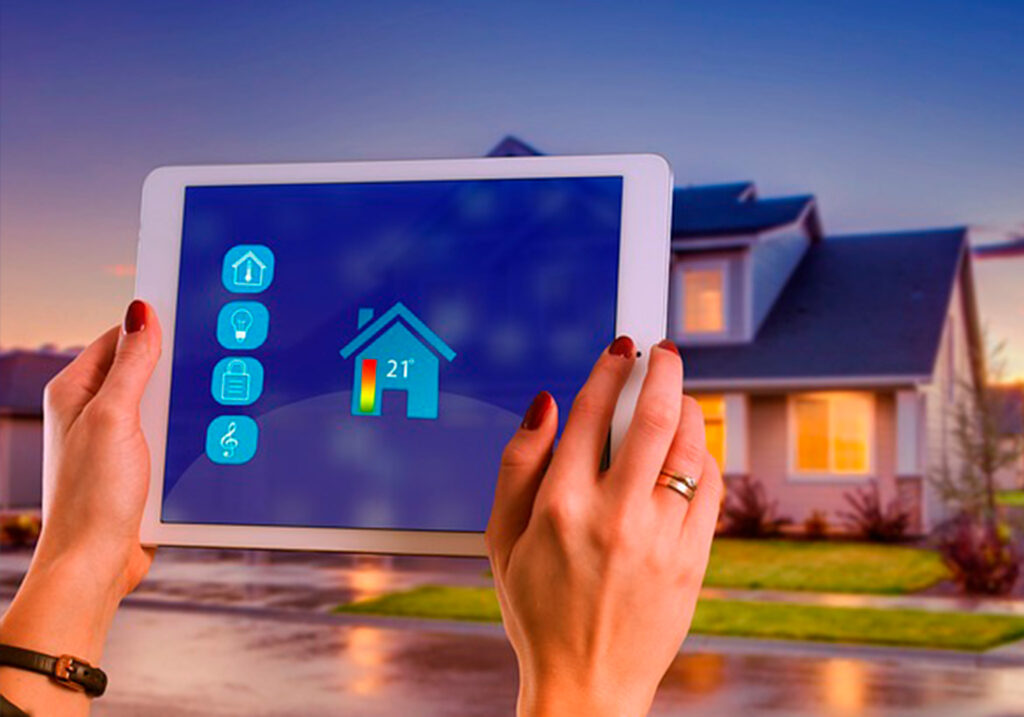Smart homes have rapidly evolved, and with it, smart garages have become an essential part of modern living.
A smart garage offers convenience, security, and energy efficiency. It does all these by integrating technology into garage doors, lighting, surveillance, and storage.
For homeowners like you who are looking to enhance security, automate access, or create a seamless connection between your garage and smart home ecosystem, this guide from Lion Garages provides everything they need to know about smart garages.
What Are Smart Garages
A smart garage utilizes the latest technology to enhance both functionality and security, making it a significant upgrade from traditional garages. Unlike conventional setups that require manual operation, smart garages integrate Wi-Fi, Bluetooth, and automation to allow for seamless remote access and monitoring. Homeowners can control garage doors, lighting, and even climate settings through smartphone apps or voice assistants, ensuring convenience and improved accessibility. Additionally, these systems provide real-time alerts and activity logs, helping users track entry and exit points, which adds an extra layer of security.
Many modern smart garage door openers come equipped with geofencing capabilities, automatically opening or closing the door based on the homeowner’s proximity. This eliminates the risk of accidentally leaving the garage open, which can lead to security vulnerabilities and energy loss.
With these technological advancements, smart garages offer a perfect blend of convenience, security, and efficiency for modern homes.
Benefits of a Smart Garage
Enhanced Security
A smart garage significantly improves home security by offering real-time monitoring and instant notifications. Unlike traditional garage doors that rely on static codes, modern smart garage door openers feature rolling codes and encrypted signals, making it difficult for intruders to hack or duplicate access. Many systems also come equipped with automatic locking mechanisms that ensure the garage door remains secure, even if the homeowner forgets to close it. Additionally, some smart garage openers include tamper detection, which alerts users to any attempted forced entry, further strengthening home security.
Beyond smart locks and encrypted access, security cameras and motion sensors add another layer of protection. Homeowners can install high-definition cameras with night vision to monitor activity inside and outside the garage in real time. Motion sensors can trigger lights or alarms when unexpected movement is detected, deterring potential intruders. Some smart garage systems even integrate with home security systems, allowing homeowners to synchronize their garage security with their overall home protection. With these advanced features, smart garages not only safeguard vehicles and belongings but also contribute to the overall safety of the home.
Remote Access and Control
One of the biggest advantages of a smart garage is the ability to control the garage door from anywhere using a smartphone app. Whether you’re at work, traveling, or simply in another room, you can check the status of your garage door and operate it remotely. This is particularly useful if you forget to close the door when leaving home or need to grant access to a family member, friend, or delivery driver. Many smart garage systems also send notifications if the door has been left open for an extended period, preventing security risks and unwanted exposure to the elements.
In addition to remote control, many smart garage systems integrate with virtual assistants like Amazon Alexa, Google Assistant, and Apple HomeKit. With voice commands, homeowners can open or close the garage door without needing to use their hands, making it convenient when carrying groceries or handling other tasks. Some systems also offer geofencing capabilities, automatically opening or closing the garage door based on the user’s location. This feature enhances both convenience and security by ensuring that the garage door operates seamlessly without requiring manual intervention.
Energy Efficiency
A smart garage can contribute to overall energy savings by optimizing lighting and temperature control. Traditional garages often waste electricity by leaving lights on unnecessarily, but smart lighting systems use motion sensors or scheduled timers to ensure lights only activate when needed. LED smart bulbs consume less energy than standard bulbs and can be controlled remotely, allowing homeowners to turn off unnecessary lighting even when away from home. By reducing unnecessary energy consumption, these systems help lower utility bills and minimize environmental impact.
Beyond lighting, smart garages can regulate temperature with the help of smart thermostats and ventilation systems. Garages often experience extreme temperature fluctuations, which can affect vehicle performance and stored belongings. A smart thermostat can adjust the temperature based on usage patterns, keeping the space comfortable while conserving energy. Additionally, some systems sync with weather apps to make automatic adjustments based on external conditions. These features not only improve energy efficiency but also enhance the longevity of items stored in the garage.
Convenience and Automation
Automation is at the heart of a smart garage, making daily routines more efficient and stress-free. By integrating with other smart home devices, homeowners can create customized automation rules to enhance convenience. For example, the garage lights can automatically turn on when the door opens, ensuring a well-lit entry without requiring manual switches. Some systems also provide alerts when a vehicle enters or leaves the garage, allowing homeowners to track family members’ arrivals and departures. These automated features streamline daily activities while improving overall home security and efficiency.
In addition to automation, smart storage solutions help maximize garage space and improve organization. Homeowners can install motorized ceiling storage that lowers with the push of a button, making it easier to store and access seasonal items. Smart shelving systems with weight sensors notify users when supplies are running low, helping them keep track of essential items. By combining automation with smart storage, garages become more functional, efficient, and tailored to the homeowner’s lifestyle.
Key Components of a Smart Garage
Smart Garage Door Openers
Smart garage door openers replace traditional openers and allow users to control their garage doors remotely. These devices come equipped with Wi-Fi and Bluetooth connectivity, smartphone app compatibility, and real-time alerts. Some models offer additional features like voice control integration and automatic closing functions.
Smart Garage Lighting
Installing smart lights in your garage enhances visibility and improves security. Smart LED bulbs and motion-activated lighting can be controlled via mobile apps, voice commands, or automation schedules. Some smart lighting systems also offer adjustable brightness and color temperature settings to create the perfect ambiance.
Smart Security Cameras and Sensors
Security cameras provide real-time video monitoring and recording of garage activity. Motion sensors can detect movement and send alerts to your smartphone if any unusual activity is detected. Advanced security systems may include night vision capabilities, two-way audio communication, and AI-powered facial recognition to enhance security measures.
Smart Storage Solutions
Maximizing space and organization is another advantage of a smart garage. Smart storage solutions include wall-mounted racks, ceiling-mounted shelves, and automated storage lifts. Some systems even allow you to track inventory and receive reminders when tools or supplies need replenishing, making it easier to keep your garage neat and organized.
Smart Charging Stations
For electric vehicle owners, a smart charging station in the garage is a must-have. Smart chargers optimize charging times, monitor energy usage, and allow remote control via apps. Some models even integrate with solar panels to maximize energy efficiency and reduce reliance on traditional power sources.
How to Upgrade to a Smart Garage
Assess Your Needs
Before upgrading, consider what features are most important for your lifestyle. Are you primarily concerned with security, convenience, or energy savings? Understanding your priorities will help you choose the right smart garage components and ensure you make the best investment.
Choose Compatible Devices
Ensure that the smart garage devices you select are compatible with your existing smart home ecosystem. Check for integration with platforms like Amazon Alexa, Google Assistant, Apple HomeKit, and IFTTT to create a seamless smart home experience.
Install Smart Garage Devices
Installation can be a DIY project or done by a professional, depending on the complexity of the devices. Many smart garage products come with user-friendly installation guides and customer support to assist with setup. If you are unfamiliar with electrical wiring or software configuration, hiring a professional installer may be the best option.
Configure Automation and Security Settings
After installation, configure automation rules and security settings to maximize functionality. Set schedules for lighting, enable notifications for security breaches, and integrate the garage with other smart home devices to create a comprehensive automation system that enhances your daily routine.
Maintain and Update Regularly
Regular maintenance and software updates ensure that smart garage systems continue to function efficiently. Keep your devices updated to benefit from new features and security patches, and periodically check for any hardware issues that could affect performance.
Future Trends in Smart Garages
AI and Machine Learning Integration
Artificial intelligence is transforming smart garages by enabling predictive maintenance, personalized automation, and enhanced security. AI-driven systems can learn user behaviors and adjust garage settings accordingly, making operations smoother and more intuitive.
Solar-Powered Smart Garages
With the growing emphasis on sustainability, solar-powered smart garages are becoming more popular. These garages utilize solar panels to power lighting, security cameras, and EV chargers, reducing dependence on the grid and contributing to energy conservation.
Biometric Access Control
Facial recognition and fingerprint scanning are emerging as advanced security features for smart garages. These biometric authentication methods enhance security by ensuring that only authorized individuals can access the garage, adding an extra layer of protection against unauthorized entry.
5G Connectivity
Faster and more reliable internet connections through 5G technology will improve the responsiveness and capabilities of smart garage systems. This will enable real-time video streaming, instant alerts, and seamless integration with other smart devices, making smart garages even more efficient and effective.
Conclusion
A smart garage is a worthwhile investment that enhances security, convenience, and energy efficiency. By incorporating smart garage door openers, lighting, security cameras, storage solutions, and EV chargers, homeowners can transform their garages into high-tech, automated spaces. As technology continues to evolve, smart garages will become even more intelligent and integrated into the broader smart home ecosystem. By following this guide, you can make informed decisions about upgrading your garage to a smarter, more efficient space.

